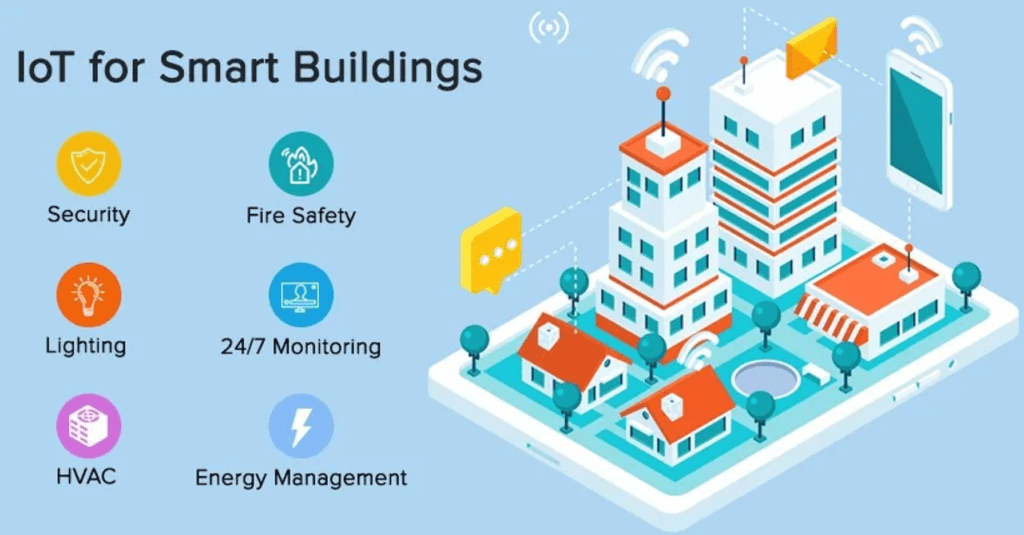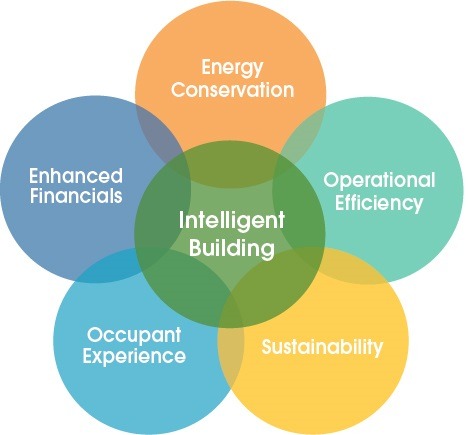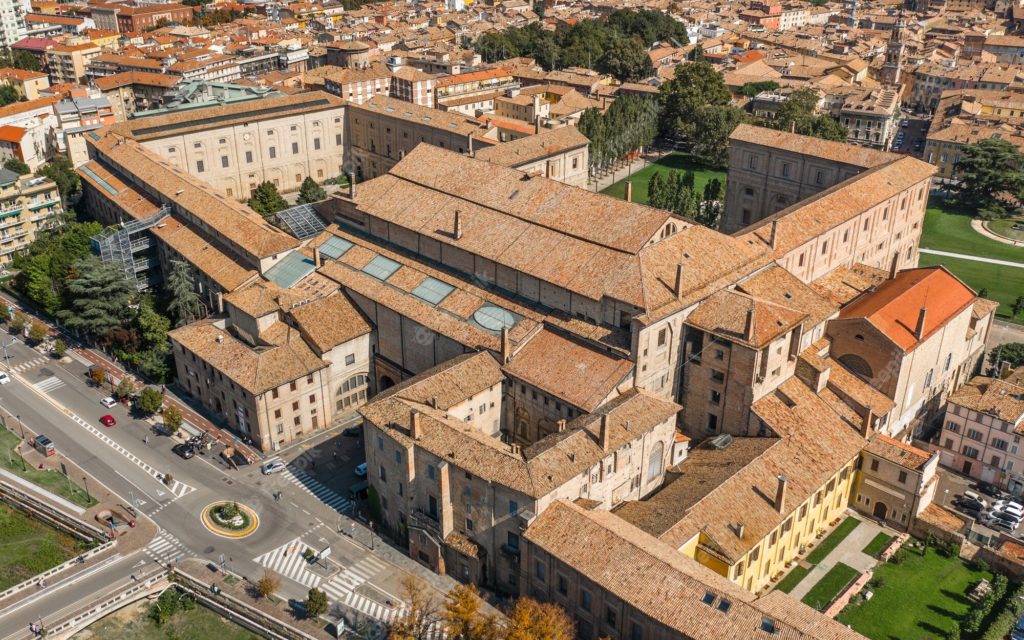
Book a demo
The Edge is an innovative building located in Amsterdam. It was designed by OMA architect Ron Bakker and has become a revolution in sustainable and energy efficient building. The building covers an area of 40,000 m2 and it is entirely controlled by the IoT, which optimises energy consumption by regulating every element of the building from lighting to heating.
The Edge has been enabled with a Smart Building System. Occupancy, routing, heating and ventilation are all controlled by the IoT system, giving the building an unprecedented 98.36% energy efficiency.
The IoT system, installed by the Dutch company Dell, is made up of 28,000 connected sensors that regulate the operation of all devices, ensuring uniformity of temperature and lighting conditions and keeping energy consumption to the lowest level/minimum.
The Edge's designers have prioritized the use of natural light and the building has large exterior windows that allow diffused light to enter the building. The aim is to reduce the use of artificial light and save energy. The Edge also uses an underground heating system for temperature management, where hot and cold water is supplied through pipes, helping to maintain the ideal temperature while reducing energy consumption.
Energy consumption analyzes show that the building was able to reduce overall energy costs by 70%.
credit: Edge.tech
The Edge received LEED Platinum certification from the US Green Building Council in 2016, which recognizes a building's environmental credentials. The building design focused on employee comfort and facilities were installed to meet these standards. It has become a model for sustainable, energy-efficient homes that combine human comfort with minimal environmental impact.
Using innovative technologies, applying new green designs and materials, and focusing on occupant comfort, The Edge is a fantastic example of how buildings can be made sustainable and energy efficient. The building's levels of energy efficiency, technological innovation and ergonomic design have made it a significant benchmark for environmentalism.
A real example of how it is possible to reshape our notions of energy and resource management in building construction.
Discover how IoT technology can revolutionize your business operations and increase your efficiency. Contact Us and explore our range of IoT solutions that can help you enhance your operations and reduce your energy consumption. Let us help you transform your business and build a sustainable future.
Fill out the form at the end of the page to request information on products or partnerships.
For prediction, we mean to foretell the occurring of an event in advance according to hypotheses based on mathematical calculi.
Within the word “prediction”, are stored all the essence and the desire that drive monitoring. Today, we can’t be happy with the mere knowledge of what’s happening to a thing in real-time. We need to predict the future on the basis of past events.
Monitoring means the continuous observation of a thing, physical size, or of the descriptive mathematics of a thing. The thing constitutes the asset (tangible or intangible) that must be monitored constantly in time.
Time is the fundamental measure the governs monitoring. It’s obvious that in our reality the “spread of time” is continuous and can be discerned. In other words, we can claim that in the real world the concept of atomicity is in force, meaning that if we take a time interval, we can then segment it into infinite instants. In monitoring, instead, we cannot “continuously” grasp (or acquire) a physical measure. In mathematical terms, there is no such frequency of infinite data acquisition. That’s why we have to settle for moderate data acquisitions scanned at a certain frequency.
The frequency of acquisition is responsible for the subdivision of monitoring in two macro areas:
“High” and “low” frequencies are quantified according to their application. For instance, in infrastructure monitoring, the boundary between dynamic and static can be drawn around 10-20 Hz.
All the measures subject to monitoring are characterized by a progression in time whose variations can depend on other variants which, in turn, may or may not be subject to monitoring. According to this, monitoring makes up for an incredible tool to identify correlations among physical measures in a monitoring system.
In any case, however we may employ it, whoever works with monitoring tools must know how to use a set of Time Series that characterize any acquired physical measure.
In ogni caso, a prescindere dall’uso che se ne fa, chiunque opera nel monitoraggio deve destreggiarsi con una serie di Time Series caratteristiche di ogni grandezza fisica acquisita.
Prediction, in monitoring, makes up the meeting point between civil-environmental engineering and data science.
All the civil works built in the modern-contemporary age are designed according to the laws of the Science of Construction and Statics which dictate the rules on the dimensions of beams and load-bearing structural elements. Moreover, they take into account how the work interacts with itself and the surrounding environment.
thus, civil-environmental engineering provides us the main engineering properties describing the nominal conditions of a project - that is the final, expected numerical values. In other words, the nominal value of engineering properties constitutes the values at the work’s beginning and then changes during the normal life of the work.
The observation of variation in time of these engineering values is the goal of structural monitoring.
Actually, in the design phase, we already carry out probabilistic predictions. Many parameters and coefficients coming into play at this stage are calculated on a statistical basis and according to historical data of other structures or to lab tests.
Moreover, predictions inform us that the future behavior of the work is calculated on past, characteristic data of the same work. Indeed, however similar the behavior of two structures designed in the same fashion can be, it can never be identical. The power of prediction in monitoring dwells precisely in knowing the history of the piece of infrastructure, how it “breathes” in the succession of day and night and how it reacts to external stimuli. Once we know the history, then we can determine the trends that inform us about the properties we’re examining, we can set thresholds for the predictive maintenance, above which we must intervene.
To set thresholds we must have a thorough and reliable knowledge of the piece of infrastructure's history. thresholds can be static, adaptive, and dynamic. They are calculated with historical data and selected on the basis of the type of monitoring to carry out. Anyway, predictive maintenance takes shape from the continuous comparison between different kinds of thresholds with the considered engineering properties.
The meeting point between civil-environmental engineering and data science calls for Machine Learning too. This is a helpful tool when it comes to monitoring and prediction since we can identify instances of the system based on classification and clustering by means of correlation algorithms.
A typical example is the application of classification algorithms on the correlation between two or more characteristics of the system, from which stem sub-dominions of existence. The constant monitoring of correlation provides us with further information on the past and current behavior of the structure. Thus, we can determine future trends and potential anomalies.
In the future, we will see an increasing need for monitoring systems. The fields of application are the widest and involve the use of several technologies and researches. We go from sensors (electric, optic fiber) to civil engineering, going through data science, computer science, and statistics. This dictates a multidisciplinary approach involving different profiles that have to communicate effectively with each other.
Today, we still don’t have a widespread culture of multidisciplinary monitoring - meaning that it is still a too-much underestimated subject to justify investments in the necessary resources. With these conditions, monitoring is left to not enough automated tools causing a lack of data and, consequently, a scarce knowledge on the life of the work during its normal operations. This doesn’t help the subject of monitoring to thrive.
Larger interest only comes from catastrophic events such as bridges and flyovers falling down which pushed the investments in new technologies to monitor pieces of infrastructure 24h and in real time. Moreover, the majority of roads and railways were built in the ‘50s and in the '60s. Hence, we’re almost at the end of the useful life of these works and are already showing signs of failure. These, indeed, are encouraging the installation of monitoring systems, although they are not supported by the necessary consideration they deserve.
The subject’s multidisciplinarity needs us to keep up with the times. Innovative technologies can become obsolete in few years. For instance, in a few years, Machine Learning has become a widely renowned subject and might even become obsolete in a while. That’s why we need to start thinking about applications of Deep Learning or non-supervised algorithms.
The debate continues here. Tell me your opinion on the topic.
Health, disease and aging affect everyone. Everyone invests in their well-being, for prevention and treatment. Investments are based on data, which are collected at home, in hospitals, clinical research laboratories and mobile devices. For security and privacy reasons, the data is kept separately.
Federated learning offers the possibility to address these issues, both for the general population with features common to all and for the individual in the rare or unusual case.
The variability of applications and configurations is another strong point of Federated Learning offered by Sensoworks and Frontiere:
Hospitals could use federated learning models to predict the likelihood of an individual patient developing a disease or contracting an infection after being admitted. This could help doctors make better decisions about how best to treat each patient based on their specific needs. Additionally, these predictions could be used by other organizations that work with hospital patients (such as insurance companies) in order to provide better coverage options for those who need it most.
Another area where federated learning can benefit healthcare is by helping us understand diseases like cancer or Alzheimer's disease at the genetic level better. Using federated learning models on DNA samples collected from thousands of people suffering from these conditions, researchers can gain insight into which factors contribute most to the development of these diseases.
Federated learning provides interoperability gains that positively impact healthcare professionals quickly accessing a patient’s medical information even if they are not within the organization’s internal systems (e.g., patients visiting from another country), and applying analytics. High quality medical decisions could be ensured regardless of the patient's treatment location and local knowledge of the disease. Physicians can augment their expertise with expert knowledge from other institutions, ensuring consistency of diagnoses that would not be possible otherwise, improving the effectiveness of patient care and enabling greater collaboration in the healthcare sector.
Federated learning has been used in medical research because it allows researchers to create large sets of patient data that they can then use as part of their research efforts without needing direct access to any individual's private health information. It also allows researchers who may not have access to certain medical records or resources (such as patients' genetic information) to instead access those same resources through other researchers' databases. This prevents privacy breaches while still allowing researchers access to sufficient information and insights.
As healthcare and clinical-data is scattered, gathering a data set that is complete enough to track rare cases involves combining data from various data silos. The practical challenges of any single site lacking adequate and sufficient data for rare adverse drug reaction detection and prediction, can be addressed. Likewise federated learning can assist in reaching the cohort sizes for orphan/rare disease studies and ensuring ethnic genomic diversity.
Precision medicine is a growing field in healthcare. A precision medicine study is an experimental study that uses personal data to develop a personalized treatment plan for an individual patient. The aim of these studies is to direct the treatment based on an individual person's unique genetic profile and medical history. Federated learning can be used to predict things like disease progression or patient outcomes, but it can also be used to predict patient responses to medications or other treatments. Using federated learning to analyze large amounts of patient data could help researchers identify new approaches to treating diseases like cancer and Alzheimer's at the molecular level, which could lead to more personalized treatments for patients. With access to large data sets, more precise drugs can be developed in an accelerated way.
Home health monitoring has attracted great attention for aging populations around the world. With abundant user health data being accessed by Internet of Things (IoT) devices, smart healthcare has seen many success stories. A personalized wearable device is used to collect, store and send health-related metrics, and can make medical recommendations for unusual health conditions. Nursing homes can offer specialized and constant care to the elderly. In these centers, remote health monitoring and recommendations can offer better services at reduced costs.
By unifying large data sets, new levels of well-being are offered at affordable costs.
Contact: dr. Remco Foppen
Fill out the form at the end of the page to request information on products or partnerships.
Waste management is a significant challenge for many cities worldwide. The amount of waste produced is constantly increasing, then an organised and efficient collection must be necessarily implemented. It must be efficient in order to provide timely and efficient service to citizens, and must aim to be more sustainable in terms of both environmental impact and the costs of management itself.
One of the biggest issue in waste management is the lack of information related to the waste flow. Often, waste managers do not have a complete understanding of the amounts and types of waste produced in a delimited area, making it difficult to efficiently plan the waste collection and disposal.
Moreover, many waste management systems are still manual and require a lot of time and human intervention to be performed correctly. This leads to higher costs and low efficiency in waste management.
All of this is primarily due to the presence of outdated infrastructure. Many waste management facilities are old and were not designed to support IoT technology. This makes it difficult to implement a smart picking system into existing infrastructure.
IoT (Internet of Things) technology is transforming many industries, and waste management is not an exception. IoT technology allows real-time data collection on the waste produced in a given area, and this data can be used to improve the management of the process. Here's how smart picking can improve waste management:
IoT can thus improve waste management by providing precise and real-time information on the waste produced in a given area, allowing for more efficient waste collection and disposal planning, reducing operational costs, and increasing the recycling rate.
Here are 4 brief examples showing the effectiveness of an IoT solution:
Fill out the form at the end of the page to request information on products or partnerships.
Smart manufacturing, or the connected factory, is a central concept in Industry 4.0 and represents an evolution of the traditional approach to production. Through the use of advanced technologies, sensors, and IoT devices, companies can achieve greater efficiency and flexibility in production, allowing them to adapt to market demands more quickly and efficiently.
The intelligent factory represents the endpoint of companies' digital transformation. The goal is to create a highly interconnected and flexible work environment, where machines, production systems, and IoT devices work together to optimise production and reduce costs.
The connected factory is based on three pillars: connectivity, digitalization, and automation.
Smart manufacturing is based on the interconnection of production systems and IoT devices. These devices can include sensors, actuators, motors, machinery, robots, mobile devices, and other elements that can collect information about production activities. This data is then sent to a cloud platform, where it can be analyzed and used to make informed decisions.
The interconnection of IoT devices also enables real-time monitoring and control of production activities. For example, an AI-based IoT platform can analyze data from sensors in real-time and identify any anomalies in production. The system can then adjust production accordingly, reducing machine downtime and improving product quality.
The use of advanced technologies such as AI, machine learning, and deep learning can lead to significant improvements in productivity and product quality. For example, an AI-based IoT platform can analyze large amounts of data in real-time, identify issues, and suggest solutions to improve production. Additionally, machine learning can be used to predict machine failures, reduce machine downtime, and prevent production interruptions.
Automation is another important feature of Smart manufacturing. Automation can be used to automate production activities and reduce personnel involvement in repetitive, low-value tasks. This can free up personnel to perform higher value-added activities such as design, innovation, and system maintenance.
The adoption of these technologies can lead to increased competitiveness for the company in the market, through reduced costs, increased productivity, and greater flexibility.
Many companies have already adopted Smart manufacturing and are achieving remarkable results.
For example, the German company Siemens has implemented a flexible production system that allows for quick and customized production of products requested by customers.
The American company General Electric has adopted a remote monitoring system based on IoT, which allows for real-time monitoring of machine performance and prevention of potential breakdowns.
According to a study conducted by McKinsey, the adoption of advanced technologies such as artificial intelligence and automation can lead to a 20-30% increase in productivity and a 10-20% reduction in costs.
Fill out the form at the end of the page to request information on products or partnerships.
A Smart Building is a structure that uses advanced technology to optimize its performance and improve the comfort, safety, and productivity of its occupants. They use a variety of sensors, devices, and systems to collect data from the building's facilities and environment and use this data to control and automate building functions such as heating, cooling, lighting and security.
One of the key components of a smart building is the use of an Internet of Things (IoT) platform, which serves as a central hub for data collection (monitor), analysis of building system data (predict) and for controlling and automating building functions (control).
IoT platforms often use artificial intelligence (AI) and machine learning algorithms to analyze data and identify patterns and trends, which can be used to optimize building performance and make data-driven decisions.
Smart buildings can offer a wide range of benefits, such as increased energy efficiency, improved comfort and productivity for occupants, enhanced security and reduced maintenance costs. They also have the potential to play an important role in addressing global sustainability and environmental challenges.
After defining what a Smart Building is, we list the important aspects to consider based on our experience applied to the projects we have developed.

An intelligent IoT platform can address the issues of a Smart Building by providing advanced automation and analytics capabilities, therefore:

An intelligent IoT platform can provide several benefits in terms of cost reduction, sustainability, and social impact:

The exact percentage of cost reduction, energy savings, and other benefits depends on many factors such as the specific implementation and goals.
There are several studies from authoritative sources that have estimated the benefits under certain conditions.
For example, according to a study by the Rocky Mountain Institute, smart building projects can save building owners up to 20-30% on energy costs and up to 15-20% on maintenance costs.
The National Renewable Energy Laboratory (NREL) reported in a study that, on average, commercial buildings can achieve energy savings of up to 20% by implementing IoT-enabled building automation systems.
A study by the McKinsey Global Institute reported that IoT-enabled building systems can reduce energy consumption by 10-20% and improve overall building efficiency by 5-15%.
Fill out the form at the end of the page to request information on products or partnerships.
Public lighting is a relevant - and sometimes taken for granted - component of urban life, fundamental in terms of safety and comfort, but it is also used as an aesthetic element to adorn our cities by highlighting, for example, the historical monuments. However, up until now, its management and maintenance were often complex and expensive due to manual management that did not permit complete control on parameters such as consumption, faults, and various issues.
Now, thanks to IoT technology, public lighting is undergoing a revolutionary evolution that is changing the way we see and interact with our urban environment. With IoT, cities can become safer, more efficient, and more attractive, creating a “brighter” future for all of us.
The disconnected lighting can lead to various problems in the management of city public lighting:
IoT offers a solution to the problems listed above, thanks to its ability to gather together all the data coming from the various components of public lighting systems in real-time, allowing a more centralised and efficient management and a greater optimization of costs. For example, local authorities can monitor and control in real time public lighting systems remotely, identify any problems and intervene quickly to resolve them. Furthermore, IoT allows for better energy management, through automatic regulation of the light intensity according to needs
Therefore, the advantages in summary are:
Energy savings and cost reduction, of course, varies depending on several factors such as the size of the city or the amount of monuments to be illuminated. But some studies have shown that the adoption of connected public lighting systems can lead to an average energy savings of 40-60% and a cost reduction of up to 50% or even more in particular conditions.
In conclusion, connected public lighting represents an important step forward in managing the city and the lives of its residents. With its ability to improve safety, energy efficiency, and the comfort of public spaces, the adoption of connected lighting systems with IoT software solutions can bring a series of benefits to cities and their residents. Additionally, the adoption of connected lighting systems can help reduce environmental impact, improve the quality of life for citizens, and promote sustainable development of cities.
Fill out the form at the end of the page to request information on products or partnerships.
Cultural heritage is a fundamental component of a country's history and identity. Historical buildings, in particular, are tangible symbols of our heritage and have to be preserved for the upcoming generations. However, the preservation of these buildings is often complicated due to several practical facts and how to implement the proper systems of prevention without compromising the architectural aspects.
Luckily, technology is offering new solutions to preserve these precious treasures. Structural monitoring and predictive maintenance are two technologies that are making a significant difference in the preservation of historical buildings.
Monitoring involves the use of sensors and surveillance technologies to constantly monitor the structural integrity of buildings. Thanks to an IoT platform it is possible to collect and process a huge amount of data, which are collected from sensors installed in the structure. Monitor, detect, control the signs of degradation such as cracks or settling, and provide the maintenance team with useful information. This allows anomalies to be quickly identified and measures taken to prevent further deterioration.
On the other hand, AI algorithms are implemented for predictive maintenance, as a matter of fact algorithms analyse and train data collected from sensors and the outcome is a prediction about the maintenance plan that should be followed. This allows conservation managers to plan preventive maintenance instead of having to react only when problems become severe.

In Italy, these IoT technologies are already making a big difference in the preservation of historic buildings. For example, the Colosseum in Rome has been equipped with an advanced monitoring system that constantly monitors its structural integrity. This has allowed the identification of the anomaly and prevention from worsening.

Another example is the Palazzo della Pilotta in Parma, which has been equipped with a monitoring system that includes predictive maintenance. This system uses sensors and AI algorithms to constantly monitor the structure and predict future maintenance problems. This has reduced maintenance costs by scheduling preventive interventions and ensuring long-term preservation of the palace itself.
To sum up, the overall benefits of intelligent monitoring of historic buildings and sites are:
In conclusion, the past offers many opportunities to preserve our future. Through monitoring and predictive maintenance, we can protect historical buildings for future generations and ensure our legacy is preserved forever.
Fill out the form at the end of the page to request information on products or partnerships.
This article’s purpose is to highlight how an IoT platform for structural monitoring can provide innovative solutions for monitoring and managing tunnels. The processes of safety and operations are smooth and sustainable, nonetheless also the software technology provides a safe environment for the users and workers.
Structural monitoring is a process that involves collecting and constantly analyzing data about the health status and safety of a structure, such as a bridge, building, or tunnel. To facilitate this process, sensors and advanced technologies have been introduced in recent years to continuously monitor the structure and identify signs of deterioration or damage. Structural monitoring was created to ensure the safety of structures and prevent accidents or collapses, and it can also help identify problems in advance and plan more efficient and cost-effective maintenance or repair work. It has also proven to be useful in optimising operational processes and ensuring that the structure is used safely and efficiently. In fact, data collected from structural monitoring can be used to assess the reliability of the structure and identify any design or construction problems.
The infrastructures authority are facing increasingly critical challenges in managing tunnels every day, such as safety, maintenance, and durability, but not only:
Industry operators are witnessing a growing need for innovative solutions in tunnel monitoring and management. Specific challenges in tunnel management, such as safety, maintenance, and longevity, require continuous monitoring and efficient management. Innovative solutions, such as IoT structural monitoring platforms, can help overcome these challenges and ensure optimal tunnel management. Let's see how.
Adopting an IoT structural monitoring platform offers numerous advantages, including: safety:
Fill out the form at the end of the page to request information on products or partnerships.
As the digitization process of enterprises advances, the need to protect sensitive information and data is also becoming more pressing. In fact, digital transformation is not just about mere technological advancement: it is also about constant attention to the development of effective strategies to safeguard smart networks from potential cyber-attacks. In this sense, cybersecurity assumes primary importance and must be among the priorities of a company that really wants to call itself innovative and open to the future.
Speaking of 2022 cybersecurity-themed trends, Gartner calculated that by 2025, 45 percent of companies will have been victims of supply chain cyber-attacks. However, companies that adopt mesh architecture will be able to reduce the impact of individual attacks by up to 90%.
In this context, it is more critical than ever for companies to have frameworks that identify hacker attacks, protect technology systems, and detect and neutralize threats. An Industrial Internet of Things (I-IoT) system, in addition to optimizing the production process by making it more efficient, should also include strict security controls. The basic principles of cybersecurity (the so-called "CIA" criteria, Confidentiality, Integrity, Availability) are as valid as ever in an Industry 4.0 context in which, according to Niccolò De Carlo, CEO of Sensoworks, the best approach to create an effective and functional protection system is definitely a holistic one. In fact, attention to data collection, storage, and use must be part of a broader and more comprehensive cybersecurity perspective.
In light of an industrial scenario so fertile with digital opportunities and innovations, Sensoworks stands as a partner able to offer targeted solutions to enable companies to preside over the digital transition and, at the same time, ensure that their data is always adequately protected.
Indeed, security protocols and technologies are fundamental to Sensoworks: in addition to collecting, monitoring, and interpreting data from sensors connected to machinery and infrastructure, the platform is easily configured to best preserve sensitive information.
In addition, the entire production process is protected through blockchain technology, a shared structure that cannot be modified within which data is entered that, once entered, will not be tweaked or deleted— a guarantee of the correct information that is essential to ensure all-around cybersecurity.
We have seen how developing effective strategies to protect data and networks from potential cyber breaches is now imperative. At the same time, however, as Sensoworks CEO De Carlo reminds us, it is also necessary to study effective strategies for the physical security of the infrastructure.
An example of an architecture that involves both physical and technological structure might be an integrated water system. Here, through cyber-infrastructures such as smart water networks, IoT, data-science techniques, augmented intelligence, and, indeed, blockchain, it is possible to make more informed decisions in real-time precisely because of sensors and instrumentation that are in charge of securely collecting and transmitting data.
Thus, one can see how knowledge and data security act to support business decisions, while also giving greater awareness of water consumption and value.
"We are reaching 3.5 billion connected devices globally. Our use of most of these devices to date plays a strategic role for our country," De Carlo points out.
"Let's think for a moment about road infrastructure, power generation infrastructure. They are increasingly connected and need to be preserved from any kind of risk. Thanks to technologies like Sensoworks', it is possible to identify if a device, a sensor, a device is not working properly or if it has been intentionally tampered with."
Stay tuned to our social channels so you don't miss any upcoming updates.
Contact Eleonora Stragliotto, Head of Sales, to learn more about how the Sensoworks platform protects sensitive information and data.